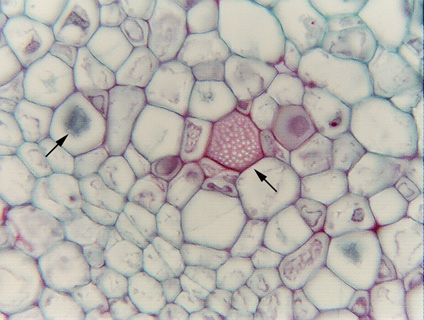 Fig.
8.2-6. Transverse section of cucumber (Cucumis
sativus). Teaching labs for Plant Anatomy almost always use samples of
cucurbits (such as squash, pumpkin, cucumber) for showing sieve plates in
transverse section. These plants have some of the very largest sieve plates of
all plants, especially in the stalk of the developing fruit (the phloem must
transport a lot of sugar rapidly if a tiny ovary is to develop into a giant
pumpkin in just a month or two). This section of cucumber has caught a sieve
plate (red structure at the end of the arrow) lying parallel to the
plane of the section. The white dots are the sieve pores.
Fig.
8.2-6. Transverse section of cucumber (Cucumis
sativus). Teaching labs for Plant Anatomy almost always use samples of
cucurbits (such as squash, pumpkin, cucumber) for showing sieve plates in
transverse section. These plants have some of the very largest sieve plates of
all plants, especially in the stalk of the developing fruit (the phloem must
transport a lot of sugar rapidly if a tiny ovary is to develop into a giant
pumpkin in just a month or two). This section of cucumber has caught a sieve
plate (red structure at the end of the arrow) lying parallel to the
plane of the section. The white dots are the sieve pores.
The other arrow (on the right, pointing to a blue object) is indicating part of a P-protein plug.